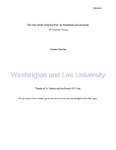| dc.rights.license | In Copyright | en_US |
| dc.creator | Sheridan, D. Graham, Jr. | |
| dc.date.accessioned | 2013-11-22T18:33:35Z | |
| dc.date.available | 2013-11-22T18:33:35Z | |
| dc.date.created | 2011 | |
| dc.identifier | WLURG38_Sheridan_POV_2011_wm | |
| dc.identifier.uri | http://hdl.handle.net/11021/24150 | |
| dc.description | Capstone; [FULL-TEXT FREELY AVAILABLE ONLINE] | en_US |
| dc.description | D. Graham Sheridan, Jr. is a member of the Class of 2011 of Washington and Lee University. | en_US |
| dc.description.abstract | Policymakers and public officials constantly debate how best to assist the poor. Currently, the debate rages about whether the government is too large, and whether shrinking the government means eliminating many public assistance programs, such as aid for heating in the winter, WIC, or food stamps. Those who want to cut such federal programs say that such aid is beyond what government is meant to do. The CATO institute, a powerful right-wing organization, calls for charity to fill this role, in the place of the federal government. America does, in fact, give quite a lot of money to charity each year- hundreds of billions of dollars. Yet, can charity do what the CATO Institute claims it can? This paper explores charity from a variety of facets, concerned primarily on charity aimed at helping the poor -- the kind of charity the CATO institute wishes to replace federal efforts. The paper starts in a more abstract fashion, and moves to a more detailed empirical analysis of how charity works in our country. First, I will look at why people give charity -- ethical, religious, and philosophical arguments for assisting the poor, especially arguments of justice. Then, I will discuss economic analyses of giving to the poor and why people give charity. Third, I will look at how charitable giving works in the United States, asking how much charity helps, and if it could or should replace America's public safety net. [From Introduction] | en_US |
| dc.description.statementofresponsibility | Graham Sheridan | |
| dc.format.extent | 23 pages | en_US |
| dc.language.iso | en_US | en_US |
| dc.rights | This material is made available for use in research, teaching, and private study, pursuant to U.S. Copyright law. The user assumes full responsibility for any use of the materials, including but not limited to, infringement of copyright and publication rights of reproduced materials. Any materials used should be fully credited with the source. | en_US |
| dc.rights.uri | http://rightsstatements.org/vocab/InC/1.0/ | en_US |
| dc.subject.other | Washington and Lee University, Shepherd Poverty Program | en_US |
| dc.title | The State and the Collection Plate: the Possibilities and Limitations of Charitable Giving | en_US |
| dc.type | Text | en_US |
| dcterms.isPartOf | RG38 - Student Papers | |
| dc.rights.holder | Sheridan, D. Graham, Jr. | |
| dc.subject.fast | Poverty | en_US |
| dc.subject.fast | Cato Institute | en_US |
| dc.subject.fast | Altruism -- Psychological aspects | en_US |
| dc.subject.fast | Nonprofit organizations -- Charitable contributions | en_US |
| dc.subject.fast | Social justice | en_US |
| dc.subject.fast | Community development -- Economic aspects | en_US |
| dc.subject.fast | Economic assistance, Domestic | en_US |
| dc.subject.fast | Altruism -- Economic aspects | en_US |
| local.department | Shepherd Poverty Program | en_US |
| local.scholarshiptype | Capstone | en_US |
